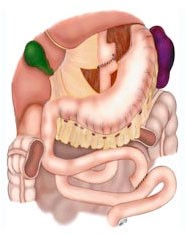
In the Roux-en-Y gastric bypass, an egg-sized portion of the stomach is surgically divided from the rest. This new, smaller stomach severely restricts the amount of food you can take in. And while the larger, lower portion of the stomach never holds food again, it does continue to help with digestion.
A Y-shaped segment of your small bowel is attached to the small new stomach. The other branch of the bowel remains attached to the larger, lower stomach. This delays the mixing of food with digestive juices, resulting in reduced absorption of calories and ultimately, weight loss.
Gastric bypass is an option for individuals who have a body mass index (BMI) of at least 40. For a woman, this equals about 80 pounds over ideal body weight and for a man, about 100 pounds over ideal body weight.
Gastric Bypass surgery may also be an option for those with a BMI of at least 35 who also suffer from another obesity-related condition like type 2 diabetes, heart disease, high blood pressure or sleep apnea.
Learn if you qualify for weight loss surgery.
If you are a candidate, read more about what you should do before gastric bypass surgery at Atlanta’s Center for Weight Management at Northside Hospital.
We are excited to help you start your weight loss journey to healthier living. To start the conversation, please give us a call at one of the following locations: